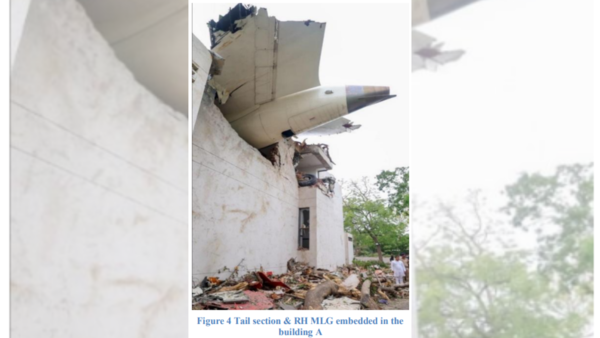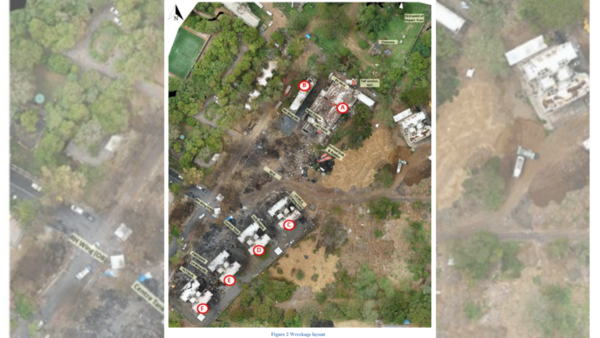NEW DELHI: The crash of Air India flight AI 171 on June 12 has been traced back to a sudden and unexplained fuel cutoff to both engines just three seconds after takeoff from Ahmedabad, the Aircraft Accident Investigation Bureau (AAIB) has revealed in its preliminary report. The report, released Saturday, includes a detailed timeline of the final moments of the London-bound Dreamliner, supported by critical images showing the impact trail, wreckage, and damage to key aircraft components.Images included in the report capture the dramatic descent of the Boeing 787 as it clipped treetops, an incineration chimney, and then collided with the BJ Medical College hostel building just 1.6 km from the runway. The aircraft, weighing 213.4 tons—nearly its maximum takeoff weight—never gained sufficient altitude after lift-off.“The aircraft achieved maximum recorded airspeed of 180 knots… and immediately thereafter, the engine 1 and engine 2 fuel cutoff switches transitioned from RUN to CUTOFF position one after another with a time gap of one second,” the report states. This caused both engine fan rotation speeds (N1 and N2) to fall below minimum idle, deploying the Ram Air Turbine (RAT), as captured in airport CCTV footage.

The pilots declared a “MAYDAY MAYDAY MAYDAY” distress call 26 seconds after lift-off. Cockpit recordings revealed one pilot asking the other why the engines were shut off, with the second responding, “he did not do so.”
Images from the crash site offer further insight:

This image shows the initial impact zone as the aircraft descended rapidly after takeoff. The Dreamliner first made contact with a cluster of trees and an incineration chimney located inside the Army Medical Corps compound, indicating its dangerously low altitude. (Image credit: Preliminary Report AAIB)
Aircraft attitude at the time of impact with Building A

From the point of first contact with the trees to where the aircraft hit Building A’s northeast wall, the distance measured was 293 feet. This highlights the short time frame and minimal altitude the aircraft had before impact. (Image credit: Preliminary Report AAIB)
Inboard parts of the right wing were found in Buildings A & B and the areas surrounding the buildings.

Captured here is the detachment of the right engine. After skimming across the roof of Building A, the right engine struck a concrete water tank structure, got separated from the main body of the aircraft, and eventually came to rest beneath the tank, facing approximately 226 degrees near the southwest wall of the building. Debris from the inboard sections of the right wing was also found scattered across Buildings A and B and the adjacent surroundings, indicating the force and fragmentation at impact.
The right engine detached after hitting a concrete water tank on the roof, resting near the building’s southwest wall. Parts of the right wing were scattered across Buildings A and B.

The left engine got separated from the airplane and struck the north corner of Building D at the ground level where it remained and was roughly perpendicular to the right engine resting position, at heading of approx. 326 degrees. (Image credit: Preliminary Report AAIB)
Image documents the flap handle assembly, burned but fixed in normal takeoff setting, and the landing gear lever still in the “DOWN” position.

The nose landing gear (NLG) (fig. 9) was found on the ground about 307 feet southwest from the initial point of contact with Building A. (Image credit: Preliminary Report AAIB)
Flap handle locked in normal takeoff position; landing gear found in ‘DOWN’ setting

The landing gear lever was found in the “DOWN” position (Figure 12), suggesting it had not yet been retracted by the time the emergency unfolded. These findings were also corroborated by data from the Enhanced Airborne Flight Recorder (EAFR). (Image credit: Preliminary Report AAIB)
The flap handle assembly (fig.11) sustained significant thermal damage. The handle was found to be firmly seated in the 5-degree flap position, consistent with a normal takeoff flap setting.

This image documents the condition of the flap handle assembly (Figure 11), which suffered significant thermal damage due to the post-crash fire. Despite the damage, the handle was firmly set in the 5-degree position, which is consistent with a normal takeoff configuration. (Image credit: Preliminary Report AAIB)
RAT deployment seconds after lift-off, with no evidence of bird activity in the vicinity.

This image is from airport CCTV footage, capturing the moment the Ram Air Turbine (RAT) deployed during the initial climb—a few seconds after liftoff. The RAT deployment indicates a severe loss of engine power, as it is only activated when both engines drop below idle speed and the aircraft needs emergency hydraulic and electrical power. The CCTV footage confirmed that no significant bird activity was present in the vicinity, ruling out a bird strike. EAFR data also verified that both engines’ N2 values fell below idle, triggering the RAT’s hydraulic pump to start supplying power at 08:08:47 UTC.
Flight data preserved: Forward EAFR powered by backup system even after crash

The thrust lever quadrant sustained significant thermal damage. Both thrust levers were found near the aft (idle) position. However, the EAFR data revealed that the thrust levers remained forward (takeoff thrust) until the impact. Both fuel control switch were found in the “RUN” position. (fig.13) The reverser levers were bent but were in the “stowed” position. The wiring from the TO/GA switches and autothrottle disconnect switches were visible, but heavily damaged. (Image credit: Preliminary Report AAIB)
Despite attempts to restore fuel supply (engine 1 and 2 fuel switches flipped back to RUN within 14 seconds), it was too late. The aircraft crashed at 1:39:11 pm (IST), just 32 seconds after becoming airborne.While the precise cause behind the fuel cutoff remains under investigation, the report notes a 2018 FAA bulletin warning of possible disengagement of the fuel control switch locking feature on similar aircraft. Air India, however, had not performed inspections as the advisory was non-mandatory.Air India responded to the report, stating: “We continue to mourn the loss and are fully committed to providing support during this difficult time. We acknowledge receipt of the preliminary report… and continue to fully cooperate with the AAIB and other authorities.”The final investigation is ongoing and may determine whether mechanical failure, human error, or design vulnerabilities led to the switches’ sudden transition from “RUN” to “CUTOFF.”

The APU air inlet door (fig. 10), which was intact, was found open. The fuselage fragmented and sustained thermal damage as it traveled along the northwest faces of Buildings C, D, E, and F with the furthest debris observed at about 765 feet southwest from the initial point of contact with building A. (Image credit: Preliminary Report AAIB)

The vertical stabilizer (fig. 5) separated from the aft fuselage and came to rest about 200 feet south of the initial point of contact with the Building A. The tail section and the RH Main Landing Gear (MLG) of the aircraft were found embedded in the northeast wall of the Building A while the rest of the airplane continued its forward movement. (Image credit: Preliminary Report AAIB)


